Allergy Relief 101 with Dr. Kingsley Chin

We recently sat down with Dr. Kingsley Chin of Piedmont Ear, Nose, Throat & Related Allergy to get an overview of allergies and different treatment options. Dr. Chin is board certified by the American Board of Otolaryngology. He received his medical degree from the University of California, San Francisco, and completed his residency at the Hospital of the University of Pennsylvania. Dr. Chin has a special interest in sinus and allergy disorders and trained under the renowned surgeon who introduced endoscopic sinus surgery to the United States.
Otorhinolaryngology Explained
 I am an otorhinolayrngologist. Wow! That’s a big word – otorhinolayrngologist. What does that mean? Let’s break it down. “Oto” means ear. “Rhino” means nose. “Laryngologist” means the throat. In layman’s terms, I’m an ear, nose, and throat doctor. We treat disorders of the ear, nose, throat, head, and neck, and I also treat patients with allergies.
I am an otorhinolayrngologist. Wow! That’s a big word – otorhinolayrngologist. What does that mean? Let’s break it down. “Oto” means ear. “Rhino” means nose. “Laryngologist” means the throat. In layman’s terms, I’m an ear, nose, and throat doctor. We treat disorders of the ear, nose, throat, head, and neck, and I also treat patients with allergies.
What Are Allergies?
 Allergies affect more than 50 million Americans. This can be a very debilitating problem – from as simple as a scratchy eye to serious problems and shortness of breath requiring a visit to the emergency room.
Allergies affect more than 50 million Americans. This can be a very debilitating problem – from as simple as a scratchy eye to serious problems and shortness of breath requiring a visit to the emergency room.
What are allergies? Allergies usually are genetic, an inherited disorder in a person’s immune system where they are very sensitive to either an airborne allergen, a food, or a chemical, where [that substance] can produce an adverse reaction that normally does not affect a healthy individual.
Allergies can start right from the beginning of life, or one can develop allergies as old as 80 or 90 years old. Usually, the person has the genes for allergies, so either their father, their mother, their siblings, or their grandparents have some form of an allergy history. It is the exposure to these agents over and over again that tends to alter their immune system so that now they’re becoming a lot more sensitive to that problem.
So let’s talk about airborne allergens. Airborne allergens can be pollens, like your grasses, trees, and weeds during the different seasons. They can be from indoor items such as dust mites, cats, dogs, cockroaches, feathers, and other animals. They can be from chemicals such as tobacco smoke, perfumes, colognes, newspaper prints, gas, natural gas. They can even be from different products like metal or gold.
Allergy Symptoms
Allergies can cause numerous symptoms. Let’s start off with just the head. It can cause fatigue, ringing in the ears, runny nose, post-nasal drip, runny nose, congestion, sneezing, throat scratching, tickling, swelling, hoarseness, chronic cough, breathing problems, asthma. It can make your skin itch; you can have hives. You can have problems with your joints – arthritis. It can affect your stomach – bloating, cramping, gas, constipation, diarrhea. These all can be very troublesome to most individuals.
Most of the time, people complain of just seasonal allergies during, let’s say, spring or fall, when they have sneezing or post-nasal drainage or eyes itching or watering. But allergies can also be quite hidden, such as chronic fatigue, snoring, or congestion, and these are usually from the indoor allergens such as dust mites.
Allergy Testing
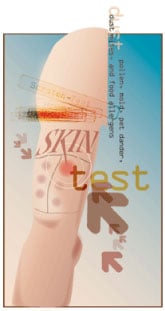 Let’s talk about how we test for allergies. There are several ways to test for allergies, and the most accurate way is by a skin test. This is relatively painless way where we use very small needles about a half inch long and almost as thin as a hair, and at the tip of the needles are different allergens that we test for. For the airborne allergens, we test for the pollens, which are the grasses, trees, and weeds. There are the dust mites, cockroaches, cats and dogs, molds, feathers, and any other unusual animals. We can also test for foods this way.We place the needles barely under the skin; they can be placed under the arm or the back. And after a ten minute period, if the person has an allergy to that agent being tested, a small little bump will form. This bump can be red, and it can itch a little bit. Now sometimes, the bumps can be larger the next day, and these are called delayed reactions; it tells us that the person is even more allergic than we thought they were the first day. The test itself can take anywhere between an hour to an hour and a half to do, depending on how sensitive the person is. Usually during the test, the patient won’t have any symptoms, but sometimes they may feel a little tired, or a little itching. Rarely do they have a serious reaction from testing.
Let’s talk about how we test for allergies. There are several ways to test for allergies, and the most accurate way is by a skin test. This is relatively painless way where we use very small needles about a half inch long and almost as thin as a hair, and at the tip of the needles are different allergens that we test for. For the airborne allergens, we test for the pollens, which are the grasses, trees, and weeds. There are the dust mites, cockroaches, cats and dogs, molds, feathers, and any other unusual animals. We can also test for foods this way.We place the needles barely under the skin; they can be placed under the arm or the back. And after a ten minute period, if the person has an allergy to that agent being tested, a small little bump will form. This bump can be red, and it can itch a little bit. Now sometimes, the bumps can be larger the next day, and these are called delayed reactions; it tells us that the person is even more allergic than we thought they were the first day. The test itself can take anywhere between an hour to an hour and a half to do, depending on how sensitive the person is. Usually during the test, the patient won’t have any symptoms, but sometimes they may feel a little tired, or a little itching. Rarely do they have a serious reaction from testing.
Allergy Treatment Options
So, what do we do with the results from the testing? If the testing shows that a person has significant allergies to outside allergens and inside allergens, then there are different ways to treat this patient. The three different ways to treat someone with allergies are to control their exposure; the second way is to take medications; and the third way is to try to boost their immune system with allergy shots.
Environmental Control
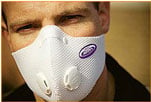 The first method, which is called environmental control, is very important no matter how bad their allergies are. It makes sense; if you’re away from your allergen, you’re not going to have the allergic reaction. So let’s talk about outside allergens such as pollen. How can you avoid the pollen? You can stay inside, but if you like being outside like myself, that’s hard to do. So let’s say I enjoy being out in the yard, mowing the lawn, or I like playing a game of golf – it’d have to be outside. Well, you can always wear a allergy mask. A tight-fighting mask will prevent the pollens from being airborne in your nose. Once you go inside, you should change your clothes immediately and take a shower. You want to wash all the pollen off your body. If you don’t do this, when you go inside, you may actually have more symptoms because now the pollen is all over you, and you don’t have the wind blowing it off.
The first method, which is called environmental control, is very important no matter how bad their allergies are. It makes sense; if you’re away from your allergen, you’re not going to have the allergic reaction. So let’s talk about outside allergens such as pollen. How can you avoid the pollen? You can stay inside, but if you like being outside like myself, that’s hard to do. So let’s say I enjoy being out in the yard, mowing the lawn, or I like playing a game of golf – it’d have to be outside. Well, you can always wear a allergy mask. A tight-fighting mask will prevent the pollens from being airborne in your nose. Once you go inside, you should change your clothes immediately and take a shower. You want to wash all the pollen off your body. If you don’t do this, when you go inside, you may actually have more symptoms because now the pollen is all over you, and you don’t have the wind blowing it off.
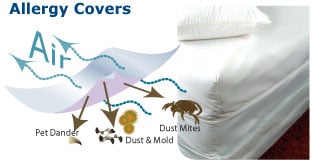 For the indoor allergens like dust mites, cats, dogs, cockroaches, and feathers, there are other ways to try to cut down your exposure. You can place allergy dust mite covers over items that tend to accumulate a lot of dust. These items are your pillows, your mattress, your bed, your box springs. Your mattress and your pillow are very difficult to wash. You can wash your sheets, but you can’t wash your mattress, so over time, your mattress will absorb a lot of dust mites. Dust mites are microscopic little critters that you can only see with a very fine microscope, and one is allergic to their droppings – their feces. That’s pretty bad if you think about it! And most patients will have millions of dust mites in their mattress and millions of dust mites in their pillows. And where do we sleep? Right next to our pillows with our noses and our eyes right next to it. So that’s probably why you feel stuffy when you wake up in the morning. It’s probably from the dust mites.
For the indoor allergens like dust mites, cats, dogs, cockroaches, and feathers, there are other ways to try to cut down your exposure. You can place allergy dust mite covers over items that tend to accumulate a lot of dust. These items are your pillows, your mattress, your bed, your box springs. Your mattress and your pillow are very difficult to wash. You can wash your sheets, but you can’t wash your mattress, so over time, your mattress will absorb a lot of dust mites. Dust mites are microscopic little critters that you can only see with a very fine microscope, and one is allergic to their droppings – their feces. That’s pretty bad if you think about it! And most patients will have millions of dust mites in their mattress and millions of dust mites in their pillows. And where do we sleep? Right next to our pillows with our noses and our eyes right next to it. So that’s probably why you feel stuffy when you wake up in the morning. It’s probably from the dust mites.
So, you can use allergy mattress covers. An allergy cover is made from materials that allow water to go through so you can wash them and allow air to go through them so they can breathe well, but dust mites cannot go through them. In essence, it’s a very fine filter. So you put your pillows or mattress or box springs and zip them up – it’s a very tight zipper – and then place your pillow case over it or your sheets over your mattress, and you have no idea that you’re sleeping on an allergy cover. These covers can be washed, and we recommend washing them in hot water; that tends to kill off dust mites as well. They’re very, very effective.
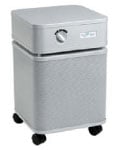 Another way to help reduce the allergens inside the bedroom is to have a good air purifier with a HEPA filter which stands for high efficiency particulate air filter. Now these filters will reduce the allergens in a typical bedroom by more than 99%. That’s very effective. What is does is, it takes the air from the room, it goes through several filters, and spits out clean air. This clean air is then re-filtered back into the unit and recycled over and over again. Typically a HEPA filter can exchange the air in one’s bedroom about six times an hour, and that can make a very big difference in how one breathes in the bedroom. When you have an air purifier from Austin Air, your bedroom door should be closed as well as the windows. The filter is usually on all day. During the daytime when you’re gone, it can be set to a higher level, and at nighttime you can turn it down to a lower level if the noise tends to bother you.
Another way to help reduce the allergens inside the bedroom is to have a good air purifier with a HEPA filter which stands for high efficiency particulate air filter. Now these filters will reduce the allergens in a typical bedroom by more than 99%. That’s very effective. What is does is, it takes the air from the room, it goes through several filters, and spits out clean air. This clean air is then re-filtered back into the unit and recycled over and over again. Typically a HEPA filter can exchange the air in one’s bedroom about six times an hour, and that can make a very big difference in how one breathes in the bedroom. When you have an air purifier from Austin Air, your bedroom door should be closed as well as the windows. The filter is usually on all day. During the daytime when you’re gone, it can be set to a higher level, and at nighttime you can turn it down to a lower level if the noise tends to bother you.
Another way to lower your exposure in the bedroom is to take out the carpet. I highly recommend hardwood floors or tile floors because they do not absorb dust mites like carpet. What absorbs dust mites? Anything that has pores – anything like a sponge. So imagine taking talcum powder and sprinkling the talcum powder on your carpet, on your bed, on your pillow, and every time you walk on the carpet, or lie on the bed, or put your head on your pillow, what happens to the talcum powder? It gets airborne. It aerosolizes – and that’s what dust mites do. So you can see how these measures really protect you from those exposures.
You want to remove your drapes – because no one washes their drapes. You don’t want books, magazines, and papers in your bedroom because they can accumulate a lot of dust. Your pets, dogs and cats, should not go in your bedroom if possible. You’ve got to get used to them scratching your door, but they’ll learn sooner or later not to go in your bedroom.
Both dust mites and molds like moisture to grow. They also like warm, dark, moist locations – like your basement and your closet; they can accumulate a lot of dust and molds. So one thing that I always recommend is to try to keep the humidity level, the moisture level, below 50% in your home. Most dehumidifiers go in the basement, but some people will need them in bedrooms if they have very high moisture contents or if they live in apartments. It’s also wise to put a light in your closet and have the light bulb always on. That will help prevent mold from growing in the closet. Or keep the closet open such that it has air to circulate. Mold tends to grow in areas that don’t have much airflow.
Allergy Medications
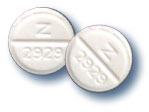 Now, after controlling your environment, if you haven’t seen that much improvement, medications can be very beneficial. There are antihistamines that are over-the-counter, such as Claritin, Benadryl, Chlortrimaton, or Actifed. And there are prescription antihistamines such as Allegra, Zyrtec, Clarinex, and Astelin. Antihistamines block the chemical histamine; that’s why it’s called anti-histamine. During an allergic reaction, histamine is released by tiny cells in your body, and histamine causes your problems. Histamine in your eyes can cause you to have tearing and blood-shot eyes. In your nose, it can make you sneeze or congested. So antihistamines block that process. However, once you stop the antihistamines, you’re back to where you were, so these medications do not cure allergies, but they help treat the symptoms. It’s good to take an antihistamine if you plan to go out in the yard to do yard work if you know you have bad allergies to pollen.
Now, after controlling your environment, if you haven’t seen that much improvement, medications can be very beneficial. There are antihistamines that are over-the-counter, such as Claritin, Benadryl, Chlortrimaton, or Actifed. And there are prescription antihistamines such as Allegra, Zyrtec, Clarinex, and Astelin. Antihistamines block the chemical histamine; that’s why it’s called anti-histamine. During an allergic reaction, histamine is released by tiny cells in your body, and histamine causes your problems. Histamine in your eyes can cause you to have tearing and blood-shot eyes. In your nose, it can make you sneeze or congested. So antihistamines block that process. However, once you stop the antihistamines, you’re back to where you were, so these medications do not cure allergies, but they help treat the symptoms. It’s good to take an antihistamine if you plan to go out in the yard to do yard work if you know you have bad allergies to pollen.
There are nasal steroid sprays that help stabilize some chemicals produced by your cells so that you don’t have as much congestion, swelling, and drainage. There are other drugs called leukotriene inhibitors, such as Singulair, that also affect one’s allergies. If one gets sick, they may need to be on antibiotics. Decongestants, drugs with Sudafed in them, can make someone breathe better, but they can be habit-forming and cause high blood pressure if they are used chronically. So medications are indeed a very important part of one’s treatment if they help their symptoms.
Allergy Shots
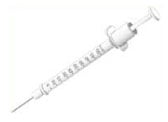 But sometimes, someone’s allergies are so strong that both medications and trying to avoid allergens is not enough to help them with their symptoms. That is when allergy shots come into play. Now, usually I recommend that patients do allergy shots if they have allergies that are more than six months of length. So, if one has allergies only during the spring or only during the fall, sometimes antihistamines are beneficial enough. But if they have problems all year-round, and they can’t be controlled by using allergy pillow covers or by using medications, then allergy shots can be very helpful for them.
But sometimes, someone’s allergies are so strong that both medications and trying to avoid allergens is not enough to help them with their symptoms. That is when allergy shots come into play. Now, usually I recommend that patients do allergy shots if they have allergies that are more than six months of length. So, if one has allergies only during the spring or only during the fall, sometimes antihistamines are beneficial enough. But if they have problems all year-round, and they can’t be controlled by using allergy pillow covers or by using medications, then allergy shots can be very helpful for them.
So what are allergy shots? Small amounts of the allergens (what patients are allergic to) are mixed into vials – small, little tubes – and this is called the allergy serum. It can be a mixture of pollens, dust, molds, cat and dog [allergens] mixed together, and these shots are given in the fat in your body. It can be given in your arm or your thigh, and once it’s in the fat, we are fooling your body. Your body is going, “What is this dust mite in here?” So it starts making antibodies against that dust mite, and these antibodies are blocking the bad antibodies that are forming your allergic reaction. This is a very slow and gradual process, so it can take at least four to six months before you have some benefit. But the good news is that this is what can cure you. If you have shots for the typical three to five years, when you stop your shots, you should probably be able to stop your medications, and you don’t have to live your life in a bubble.
Now, what is the process of doing shots. Typically, they’re done in a physician’s office, where the patient comes in, receives a shot, and waits about 20 minutes just to look for any type of side effects. The most common side effect, which is not that common at all, is just a little irritation and itchiness at the site of the injection, and it usually goes away within 24 hours. But we also need to look for serious side effects, such as troublesome breathing or a rash, but luckily, that is infrequent. Sometimes, if we have the appropriate patient and we know that they haven’t had any problems from their injections, we can train them to do this at home. When patients are able to do their shots at home, it makes them more compliant; it’s easier for them, and they don’t have to miss any work. We make sure it’s done safely. They always have someone there with them. They always have a back-up medicine called epinephrine in case they have a serious reaction, but that is very unlikely. It only takes a minute or two to self-administer two allergy shots, and you do it once a week. The more consistent one is with the allergy shots, the better results we get. If you do shots once a month or once every six weeks, it’s not worthwhile doing it. It does take some commitment, but most patients who have bad symptoms see very strong results from doing it, and they’re very committed.
Ear, Nose, and Throat Surgeries
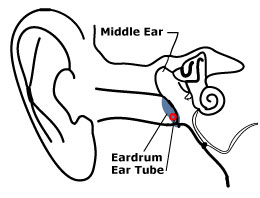 I also do surgeries, such as placing ear tubes, for patients who fail medical managements. A lot of patients see me for their sinus and allergy problems. I will do the best possible care to try to treat you without doing surgery. Most cases of even chronic sinusitis can be treated aggressively with medicines by strong allergy treatment. So this would involve testing to see you if you have allergies and if you’re a candidate for allergy shots, or just using medications, or just using environmental controls. Those rare patients, after doing all this, if they still have recurrent sinus infections, they may require outpatient sinus surgery. This is usually a painless process in the operating room. Your nose is not packed with a yard of gauze like they did 10 years ago. Most patients don’t take any pain medication after sinus surgery by me.
I also do surgeries, such as placing ear tubes, for patients who fail medical managements. A lot of patients see me for their sinus and allergy problems. I will do the best possible care to try to treat you without doing surgery. Most cases of even chronic sinusitis can be treated aggressively with medicines by strong allergy treatment. So this would involve testing to see you if you have allergies and if you’re a candidate for allergy shots, or just using medications, or just using environmental controls. Those rare patients, after doing all this, if they still have recurrent sinus infections, they may require outpatient sinus surgery. This is usually a painless process in the operating room. Your nose is not packed with a yard of gauze like they did 10 years ago. Most patients don’t take any pain medication after sinus surgery by me.
I also treat patients with throat problems, with hoarseness. These are all the different things an ear, nose, and throat doctor can do. If you have lumps and bumps in the neck, we can evaluate what those are, too. If you have trouble breathing through your nose, such as with a deviated septum, this can be repaired surgically. But most of what I do is to try to treat ear, nose, and throat disorders through proper medical therapy. I don’t like the knife; you don’t like the knife, but sometimes surgery is required to treat these disorders if you have failed the maximum treatment.
Visit Piedmont Ear, Nose, Throat & Related Allergy
Piedmont Ear, Nose, Throat & Related Allergy has moved to a new location at 1720 Peachtree Street (Atlanta, GA), on the second floor, suite 200. We have a very strong practice with three other physicians, two physician assistants, a very strong allergy clinic, a very strong audiology clinic, and a wonderful staff to help you with your needs. To learn more about this medical practice, call 404-351-5045.
Originally published in the August 2007 issue of Allergy Consumer Report.
